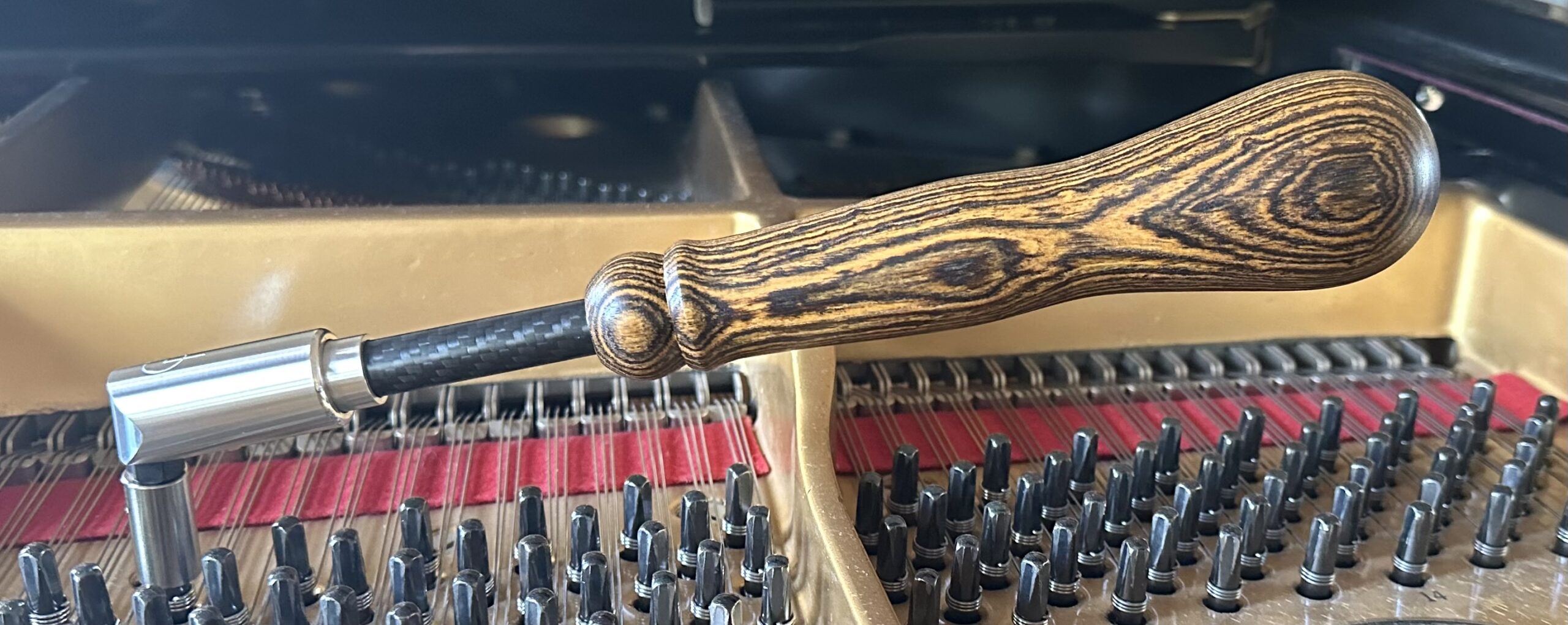
Welcome to Faulk piano service
Welcome to my new web site. I can now post new products much more quickly and serve you more efficiently. Thanks for your patience!
Charles Faulk, Registered Piano Technician, Piano Technicians Guild, is a pianist, piano technician, and professional woodworker. He has 45 years experience in piano manufacturing, piano restoration, and concert level piano work.
Mr. Faulk has been making piano tuning levers since 1996. Over the years these tuning hammers have evolved from titanium based tools to carbon fiber and metal (titanium and aluminum)/carbon fiber products. From the point of inception, his goal has been to produce levers that are lightweight, well balanced, and aesthetically pleasing to the eye. He has also redesigned the tuning head to eliminate the point loading problems of conventional tuning hammers caused by the narrowing of the tuning shaft at the threaded end.
Dear customers, again this year, I’ll be prepping for the PTG Convention in Des Moines. I won’t have any more tuning hammers until I’ve produced my quota for the convention. I should have more to post around early July. Thanks for your patience.
CURRENT PRODUCTS
 The new CF-THIN tuning hammer is much the same as the LITE, but it uses an ultra high modulus 1/2″ diameter carbon fiber tube with an 1/8″ wall. The THIN also has a smaller handle. It is designed to take up less space in your tool kit.
The new CF-THIN tuning hammer is much the same as the LITE, but it uses an ultra high modulus 1/2″ diameter carbon fiber tube with an 1/8″ wall. The THIN also has a smaller handle. It is designed to take up less space in your tool kit.
KEY STRIKING TOOL
The key striking tool is made with solid PVC and has a thick leather pad which contacts the key surface. It fits in your palm. By placing your forefinger close to the leather pad, you can orient your location on the key by touch without having to look down at the keyboard. This tool will prevent damage to your finger joints.
DEAR CUSTOMERS
Thank you for visiting FaulkPiano.com. Over the last 17 years, I have developed an array of tuning hammers dedicated to the concept of lightness and balance. These levers are so diverse that they sometimes cause confusion with you. I’m asked, “Which one is the best? Which one is the strongest? Which one will suit my needs?” I feature a variety of lengths, head angles, handle shapes, wood choices, and weights. WHY? Basically because we are all different. We see the ultimate use of this simple lever from different perspectives. We envision how our customers will react when they see this special tool come out of our tool case. We were guided by our individual physique when we learned our trade. I’ve spoken to hundreds of tuners in these years, and it’s astounding how much their approach to tuning varies. And so, it’s my belief that there is no uniform product out there that will please everyone.
Having said the above, I want to leave you with one last thought. Choosing a tuning hammer isn’t always about examining your strengths and preferences. Try to think of this tool as a ‘mate’, as something you gradually become accustomed to. You’ll find that your future preferences will be forever guided by the relationship you nurture with your tuning lever. Sounds hokey? Perhaps. But it does happen.
STRING LEVELING
The string leveling tool works differently from conventional tools. Instead of lifting the string with a hook, the Faulk string leveling tool uses leverage. The tool has grooves cut on both ends that will slip in between the strings and bend the strings very minutely by pulling or pushing on the other end of the tool. It takes very little effort and produces very precise results.
The string leveling gauge consists of an aluminum base with a vertical slot cut on one side. The base sits on the plane of the strings and references the level of the strings from the string plane rather than the level of the keybed. The string level is determined by a small ½” wide rule that rests loosely on its end on the strings. By lifting the dampers and plucking each string of the unison, you can determine the level of the strings by listening to the buzz against the rule. When all three strings of the unison buzz equally against the rule, the strings are level.


